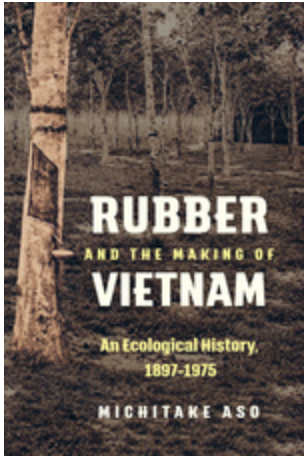 Book Cover
Book Cover
Title: Rubber and the Making of Vietnam: An Ecological History, 1897–1975
Author: Michitake Aso
Publisher: University of North Carolina Press
Published: June 2018
2018 Henry A. Wallace Award, Agricultural History Society
About the Author
Mitch Aso is an Assistant Professor of the Global Environment. Before arriving at the University at Albany, he completed a postdoctoral fellowship at the National University of Singapore. He is currently finishing a book manuscript called Forest without Birds: Rubber and Environmental Crises in Vietnam, 1890-1975, which explores the making of environments, human health, and knowledge through the places and people involved in rubber production. His dissertation on French colonial Vietnam won the 2013 Young Scholar Prize of the International Union of the History and Philosophy of Science. He has recently published articles in Modern Asian Studies, Journal of Southeast Asian Studies, and Science, Technology, and Society. He teaches courses on global environmental history and Asian history.
About This Book
Dating back to the nineteenth-century transplantation of a latex-producing tree from the Amazon to Southeast Asia, rubber production has wrought monumental changes worldwide. During a turbulent Vietnamese past, rubber transcended capitalism and socialism, colonization and decolonization, becoming a key commodity around which life and history have revolved. In this pathbreaking study, Michitake Aso narrates how rubber plantations came to dominate the material and symbolic landscape of Vietnam and its neighbors, structuring the region’s environment of conflict and violence. Tracing the stories of agronomists, medical doctors, laborers, and leaders of independence movements, Aso demonstrates how postcolonial socialist visions of agriculture and medicine were informed by their colonial and capitalist predecessors in important ways. As rubber cultivation funded infrastructural improvements and the creation of a skilled labor force, private and state-run plantations became landscapes of oppression, resistance, and modernity.
Synthesizing archival material in English, French, and Vietnamese, Aso uses rubber plantations as a lens to examine the entanglements of nature, culture, and politics and demonstrates how the demand for rubber has impacted nearly a century of war and, at best, uneasy peace in Vietnam.